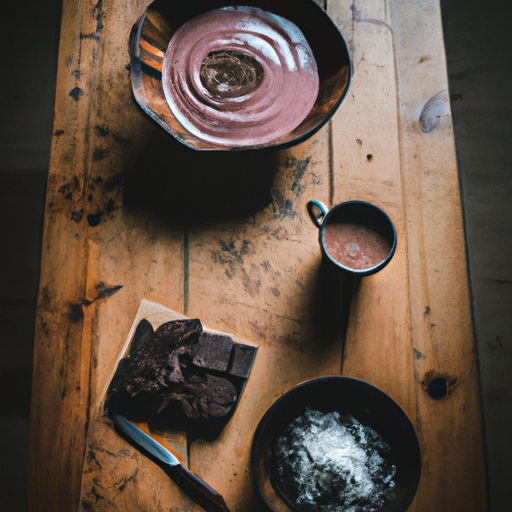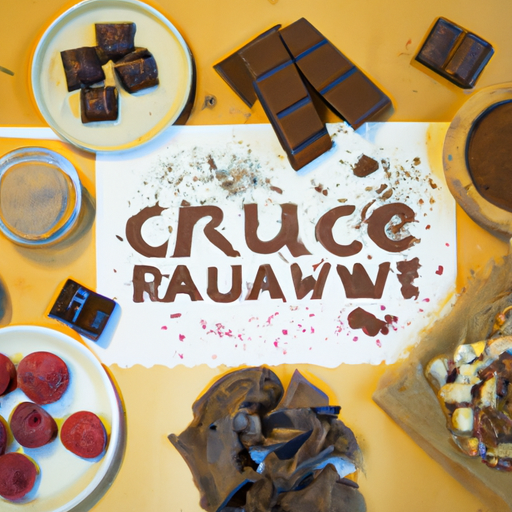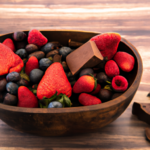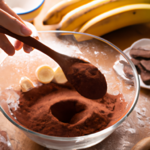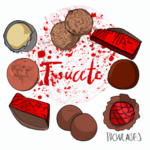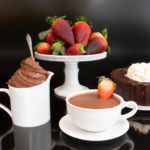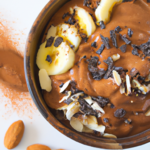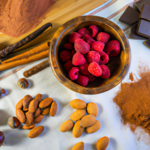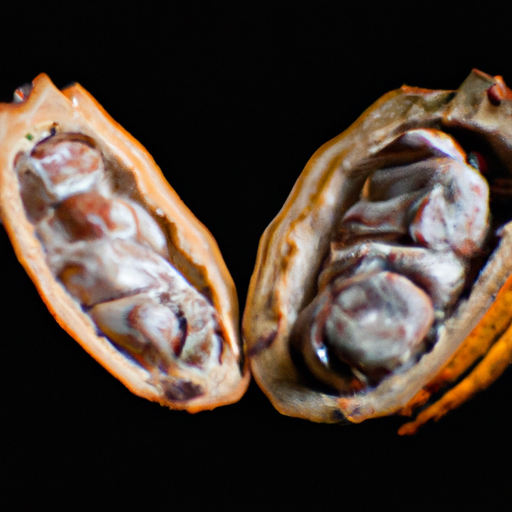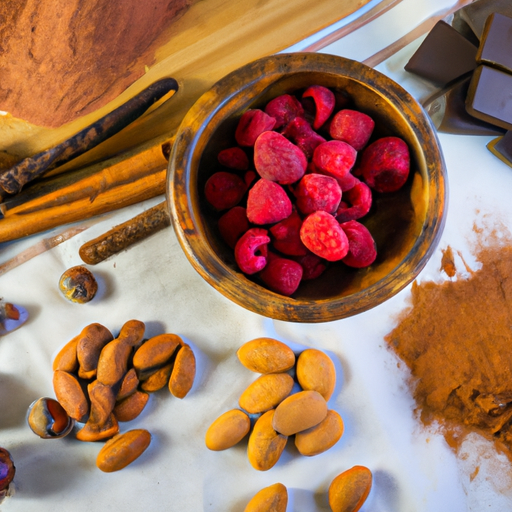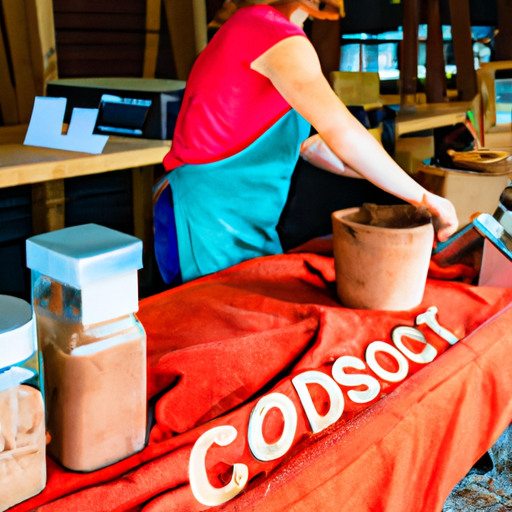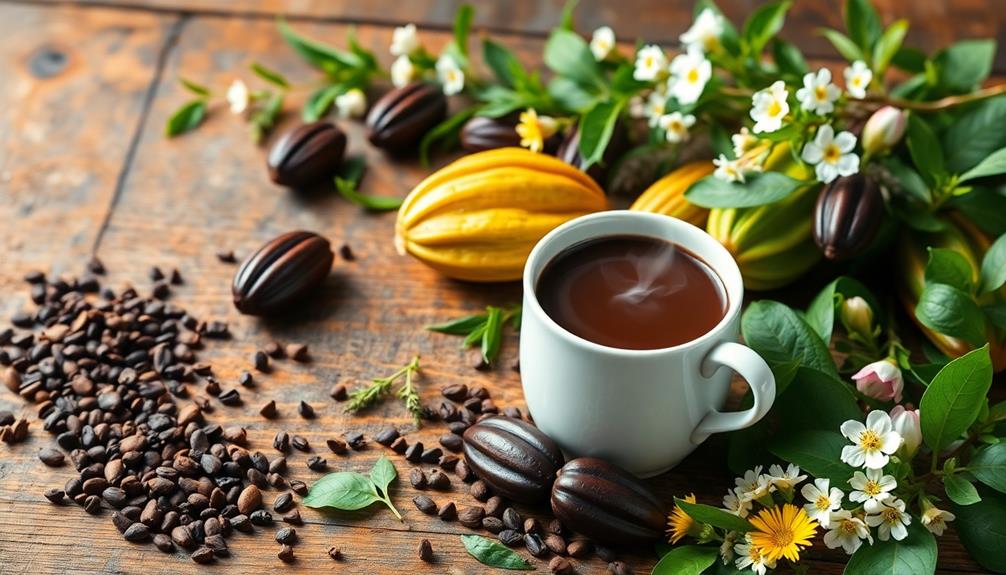Have you ever thought about the possibilities of using raw cacao? Allow me to share some delicious ideas with you!
Raw cacao, often referred to as the ‘food of the gods,’ is a versatile ingredient that can be used in a variety of delicious ways.
From decadent chocolate desserts to rich and creamy hot chocolate, the possibilities are endless. You can whip up a batch of homemade chocolate truffles, add raw cacao to your smoothies and shakes for an antioxidant boost, or make raw cacao energy balls for a healthy snack.
And that’s not all – you can also use raw cacao in baking for a nutrient-packed twist on your favorite recipes, make your own chocolate nut butter or spread, experiment with it in savory dishes, and even create raw food recipes for a healthy and delicious treat.
So, let’s dive into the world of raw cacao and discover the delectable delights it has to offer!
Key Takeaways
- Raw cacao has antioxidant properties that promote healthy skin.
- Raw cacao can be used in various drink recipes, such as smoothies and hot chocolate.
- Raw cacao adds richness and indulgence to raw food recipes.
- Experiment with raw cacao in savory dishes to enhance flavors and surprise taste buds.
Make Decadent Chocolate Desserts
You can make incredibly indulgent chocolate desserts by using raw cacao! Raw cacao is the purest form of chocolate, packed with nutrients and a rich, intense flavor.
One of my favorite desserts to make with raw cacao is chocolate mousse. With just a few simple ingredients like avocado, dates, and raw cacao powder, you can create a velvety smooth and decadent mousse that will satisfy any chocolate craving.
Another delicious option is to create a chocolate fondue using raw cacao. Melt some raw cacao with coconut oil and dip your favorite fruits or treats for a heavenly chocolate experience.
And if you’re in the mood for something warm and comforting, you can also create a rich and creamy hot chocolate using raw cacao. Just mix raw cacao powder with your choice of milk and sweetener for a delightful treat.
Now, let’s move on to creating rich and creamy hot chocolate.
Create Rich and Creamy Hot Chocolate
To create a rich and creamy hot chocolate, start by blending raw cacao powder with warm milk until smooth and velvety. The combination of the bitter cacao and the silky milk creates a decadent base for your gourmet hot chocolate.
Now, let’s take it up a notch and discover unique hot chocolate flavors.
- First, try adding a pinch of cinnamon for a warm and comforting twist.
- Next, experiment with a dash of chili powder to give your hot chocolate a subtle kick.
These unexpected flavors will elevate your hot chocolate to a whole new level of sophistication.
Once you have created your perfect cup of hot chocolate, it’s time to transition into the next section and whip up a batch of homemade chocolate truffles.
Whip Up a Batch of Homemade Chocolate Truffles
Let’s dive into the world of homemade chocolate truffles and create a batch of these delectable treats. Homemade chocolate truffles are a luxurious and indulgent dessert that are surprisingly easy to make. With just a handful of ingredients, including raw cacao, you can whip up a batch of rich and creamy truffles that will impress your friends and family.
To make homemade chocolate truffles, start by melting a combination of dark chocolate and heavy cream. Once melted and smooth, add in some raw cacao powder for an extra boost of intense chocolate flavor. Let the mixture cool and then shape it into small balls. Roll the truffles in a variety of toppings such as crushed nuts, shredded coconut, or cocoa powder.
To elevate the presentation, you can also dip some chocolate covered strawberries in the leftover melted chocolate. These juicy and sweet treats make the perfect accompaniment to your homemade truffles.
Now that we’ve explored the world of homemade chocolate truffles, let’s move on to the next exciting way to use raw cacao: adding it to your smoothies and shakes for an antioxidant boost.
Add Raw Cacao to Your Smoothies and Shakes for an Antioxidant Boost
Indulge in a velvety antioxidant infusion by infusing your smoothies and shakes with the rich, dark essence of raw cacao.
Adding raw cacao to your morning coffee creates a rich and indulgent treat that will satisfy your chocolate cravings.
Incorporate raw cacao into your breakfast bowls for a nutritious start to your day. Sprinkle it over smoothie bowls or mix it into your favorite yogurt for a burst of flavor and a dose of antioxidants.
Blend raw cacao with frozen bananas, almond milk, and a touch of honey for a decadent chocolate shake.
The possibilities are endless when it comes to incorporating raw cacao into your smoothies and shakes. Make raw cacao energy balls or bars for a healthy snack, continuing your journey of exploring the versatility of this superfood.
Make Raw Cacao Energy Balls or Bars for a Healthy Snack
Get ready to whip up a batch of deliciously healthy energy balls or bars using the amazing power of raw cacao!
Raw cacao is not only rich in antioxidants, but it also adds a deep, chocolatey flavor to your homemade snacks. Making raw cacao protein bars is a great way to incorporate this superfood into your diet.
Simply mix together raw cacao powder, dates, nuts, and any other ingredients you desire, then shape into bars and refrigerate. These protein bars are perfect for a quick snack on the go or a post-workout pick-me-up.
Another option is to incorporate raw cacao into homemade granola for a nutritious and energizing breakfast or snack. Add raw cacao powder to your granola mix along with oats, nuts, and dried fruits, then bake until golden and crispy.
Use raw cacao in baking for a nutrient-packed twist on your favorite recipes. Transitioning into the next section about baking with raw cacao, you’ll discover even more ways to enjoy this versatile ingredient.
Use Raw Cacao in Baking for a Nutrient-Packed Twist on Your Favorite Recipes
Using raw cacao in your baking creations adds a nutrient-packed twist to your favorite recipes. Not only does it provide a rich and intense chocolate flavor, but it also brings a host of health benefits.
When baking with raw cacao, you can substitute it for regular cocoa powder in recipes like brownies, cookies, and cakes. The result is a decadent and indulgent treat that is also packed with antioxidants, fiber, and essential minerals.
In addition to baking, you can also add raw cacao to your smoothies for a healthy boost of nutrients and a delicious chocolate flavor. By incorporating raw cacao into your baking, you can transform your favorite recipes into nutrient-dense delights that satisfy your sweet tooth.
Don’t forget to try making your own chocolate nut butter or spread to continue exploring the delicious possibilities of raw cacao.
Make Your Own Chocolate Nut Butter or Spread
If you thought raw cacao was only good for baking, think again! There are so many other delicious and creative ways to use this nutrient-packed ingredient. One of my favorites is making my own chocolate nut butter or spread. It’s incredibly easy and gives a healthy twist to your usual store-bought options. Here are a few ideas to get you started:
- Chocolate almond butter: Simply mix raw cacao powder with almond butter for a rich and decadent spread.
- Chocolate hazelnut spread: Blend raw cacao with roasted hazelnuts, coconut oil, and a touch of sweetener for a homemade Nutella-like treat.
- Chocolate peanut butter: Add raw cacao to your favorite peanut butter and enjoy the delicious combination of flavors.
- Chocolate cashew butter: Combine raw cacao with cashew butter for a creamy and indulgent spread.
But that’s not all! Raw cacao can also be used in beauty and skincare products for its antioxidant properties. Now, let’s move on to the next section and explore how to use raw cacao in raw food recipes for a healthy and delicious treat.
Use Raw Cacao in Raw Food Recipes for a Healthy and Delicious Treat
Indulging in the rich and decadent flavors of homemade chocolate nut butter or spread is just the beginning of the delightful journey of incorporating raw cacao into raw food recipes for a healthy and delicious treat.
Not only does raw cacao add a deep and intense chocolate flavor, but it also offers numerous health benefits. Did you know that raw cacao can be used in skincare products? Its antioxidant properties help fight free radicals and promote healthy, glowing skin.
Additionally, raw cacao can be used in drink recipes, such as smoothies or hot chocolate, to create a rich and indulgent beverage. So why stop at just chocolate nut butter? There are endless possibilities to explore with raw cacao in raw food recipes.
Now, let’s transition into the next section and discover how to experiment with raw cacao in savory dishes for a unique and flavorful twist.
Experiment with Raw Cacao in Savory Dishes for a Unique and Flavorful Twist
Get ready to embark on a culinary adventure like no other by infusing your savory dishes with the unexpected and tantalizing flavors of raw cacao. Not only is raw cacao known for its health benefits, but it also adds a unique and flavorful twist to your savory recipes. From soups to stews, and even marinades, the possibilities are endless when you experiment with raw cacao in savory dishes.
To give you an idea of how versatile raw cacao can be, here is a table showcasing three savory recipes that incorporate raw cacao:
| Recipe | Description | Ingredients |
|---|---|---|
| Cocoa-rubbed steak | A succulent steak coated in a rich cocoa rub for a deep, smoky flavor. | Steak, raw cacao powder, spices |
| Chocolate chili | A hearty chili with a hint of chocolate, adding richness and complexity. | Ground beef, beans, vegetables, raw cacao powder |
| Cacao-infused mole sauce | A traditional Mexican sauce with a velvety texture and a touch of bitterness from raw cacao. | Various spices, raw cacao powder, nuts |
Incorporating raw cacao into savory recipes is a sure way to elevate your cooking and surprise your taste buds. So, don’t be afraid to get creative and explore the endless possibilities that raw cacao has to offer in savory dishes.
Frequently Asked Questions
Can raw cacao be used as a substitute for cocoa powder in baking?
Baking with raw cacao is a great alternative to using cocoa powder. Raw cacao has a rich, intense flavor that adds depth to baked goods. It also has more nutrients and antioxidants compared to cocoa powder.
How can I incorporate raw cacao into savory dishes?
I love experimenting with raw cacao in savory dishes. One interesting statistic is that cacao infused sauces can enhance the flavors of meat and vegetables. Raw cacao in marinades adds a rich, earthy depth to grilled or roasted dishes.
Are there any health benefits of consuming raw cacao?
Consuming raw cacao offers numerous health benefits and high nutritional value. It’s packed with antioxidants, minerals, and vitamins that support heart health, boost mood, improve cognitive function, and promote overall well-being.
Can I use raw cacao in my everyday smoothies and shakes?
Absolutely! Raw cacao is a fantastic addition to everyday smoothies and shakes. Its rich, chocolatey flavor adds depth and its antioxidants provide a health boost. Try experimenting with different recipes for a creative twist!
What is the difference between raw cacao and regular chocolate?
Raw cacao differs from regular chocolate in terms of processing. While regular chocolate undergoes roasting and refining, raw cacao is minimally processed, retaining more nutrients and antioxidants. This is why raw cacao is considered healthier than regular chocolate.
Can I Use Raw Cacao Butter in Recipes Involving Raw Cacao?
Yes, you can use raw cacao butter in recipes involving raw cacao. Using tempering raw cacao butter techniques can help maintain its texture and flavor. It adds a smooth and rich taste to your raw cacao recipes, making them even more delightful. Try it in your next raw cacao creation!
Conclusion
In conclusion, raw cacao is truly a magical ingredient that can transform ordinary dishes into extraordinary culinary experiences.
From decadent chocolate desserts to creamy hot chocolate, the possibilities are endless.
With its antioxidant benefits and nutrient-packed goodness, raw cacao is not only delicious but also incredibly healthy.
So go ahead and indulge in the rich, velvety goodness of raw cacao, and prepare to be blown away by its irresistible flavor.
Your taste buds will thank you for this sensational journey into the world of cacao!

